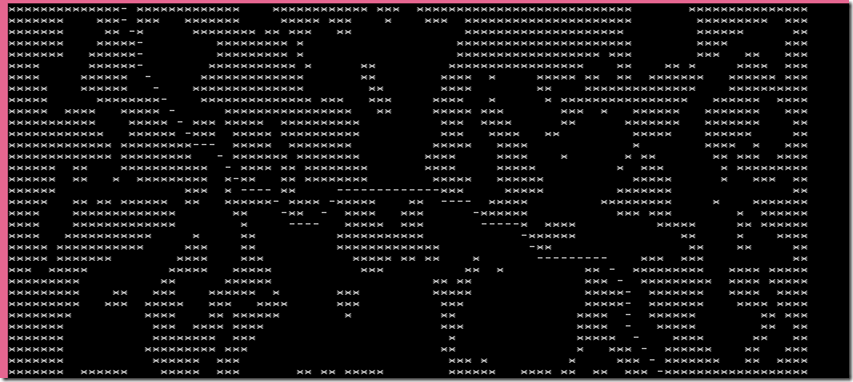A*算法是一种启发式的BFS,目的就是找到到达目标位置的最短路径。启发式函数如下:
f(x) = g(x) + h(x)
g(x)是对出发点到达当前点距离的估约,h(x)是当前点到终点距离的估约。算法是一个广度优先搜索的过程,但是搜索时的可选集合是一个优先级队列,f(x)越小优先级越高。
算法过程描述
1。用起点初始优先级队列opened;
2。在opened中取最小f(x)的坐标节点,如果该点就是终点,则成功找到返回,否则,向该点的相邻方向寻找可行的下一个移动节点,计算每一个可行节点的f(x)保存,放入opened队列中,继续步骤2;
关于最短路径的求解还应该维护一个映射表,保存移动过程的上一个节点,之后再从终点往前遍历到起点便是整条路径了。
求单源最短路径的迪杰斯特拉算法其实就是当h(x)=0的A*算法。以下是算法的伪码(摘自维基百科)
function A*(start,goal)
closedset := the empty set // The set of nodes already evaluated.
openset := {start} // The set of tentative nodes to be evaluated, initially containing the start node
came_from := the empty map // The map of navigated nodes.
g_score[start] := 0 // Cost from start along best known path.
// Estimated total cost from start to goal through y.
f_score[start] := g_score[start] + heuristic_cost_estimate(start, goal)
while openset is not empty
current := the node in openset having the lowest f_score[] value
if current = goal
return reconstruct_path(came_from, goal)
remove current from openset
add current to closedset
for each neighbor in neighbor_nodes(current)
tentative_g_score := g_score[current] + dist_between(current,neighbor)
tentative_f_score := tentative_g_score + heuristic_cost_estimate(neighbor, goal)
if neighbor in closedset and tentative_f_score >= f_score[neighbor]
continue
if neighbor not in openset or tentative_f_score < f_score[neighbor]
came_from[neighbor] := current
g_score[neighbor] := tentative_g_score
f_score[neighbor] := tentative_f_score
if neighbor not in openset
add neighbor to openset
return failure
详细设计实现
游戏中自动寻路的场景会被划分成网格,每一个网格可以是阻挡或者通路,在当前网格中可以向周围8个相邻方向移动(左,右,上,下,左上,左下,右上,右下)。运用A*算法从start寻路到end,启发式函数可以这样设计:
1。g(x)设计:初始化起点的g(start) = 0。假设当前位置是cur,下一个位置next若是cur从对角移动过来的(即左上,左下,右上,右下)则g(next) = g(cur) + 14,若是从水平或者垂直方向移动过来的,则g(next) = g(cur) + 10。常数14和10是这么得来的:勾股定理中,假设两直角边都是1,对角线则是1.414,各自放大10倍取整就是10和14;
2。h(x)设计:假设当前节点是(xcur,ycur),终点是(xend,yend),h(x) = abs(xcur – xend) + abs(ycur- yend);
优先级队列可以用最小堆来实现,但是搜索过程中可能出现这样的情况:新添加一个可用节点时,该节点已经在opened队列中了,且新节点有更小的f(x)值,这时候要更新队列中这个节点并重新调整堆。查找新入的节点是否已经在队列中了,单纯用最小堆实现时间复杂度是O(n),可以再加一个hash表,维护坐标点到最小堆中节点的映射,复杂度降为O(1)。代码实现如下:
#define TI(x, y) ((x)*H+(y))
struct OpenedNode{
int _f, _g;
int _x, _y;
int _parent;
OpenedNode(int f = -1, int g = -1, int x = -1, int y = -1, int parent = -1):_f(f),_g(g),_x(x),_y(y),_parent(parent) {}
};
template <size_t W, size_t H>
class OpenedHeap {
OpenedNode _heap[W*H];
int _set[W*H];
int _sz;
void move_top(int icur) {
OpenedNode ON = _heap[icur];
while (icur > 0) {
int iparent = (icur-1) / 2;
if (_heap[iparent]._f <= ON._f) break;
_heap[icur] = _heap[iparent];
// update
_set[TI(_heap[icur]._x,_heap[icur]._y)] = icur;
icur = iparent;
}
_heap[icur] = ON;
_set[TI(_heap[icur]._x, _heap[icur]._y)] = icur;
}
void move_bottom(int icur) {
OpenedNode ON = _heap[icur];
while (true) {
int ileft = icur * 2 + 1;
if (ileft >= _sz) break;
int iright = icur * 2 + 2;
int ismaller = iright < _sz && _heap[iright]._f < _heap[ileft]._f? iright:ileft;
if (_heap[ismaller]._f < ON._f) {
_heap[icur] = _heap[ismaller];
_set[TI(_heap[icur]._x, _heap[icur]._y)] = icur;
icur = ismaller;
}else break;
}
_heap[icur] = ON;
_set[TI(_heap[icur]._x, _heap[icur]._y)] = icur;
}
public:
OpenedHeap():_sz(0) {
memset(_set, -1, sizeof(_set));
}
void push(const OpenedNode &ON) {
_heap[_sz] = ON;
int icur = _sz++;
move_top(icur);
// ensure();
}
void pop(OpenedNode &ret) {
ret = _heap[0];
_set[TI(_heap[0]._x,_heap[0]._y)] = -1;
assert(_sz>0);
_heap[0] = _heap[--_sz];
if (_sz > 0)
move_bottom(0);
// ensure();
}
bool Get(int x, int y, OpenedNode &ret) {
if (_set[TI(x,y)] >= 0) {
ret = _heap[_set[TI(x,y)]];
return true;
}
return false;
}
bool make_smaller(int x, int y, int f, int g, int parent) {
int icur = _set[TI(x,y)];
assert(_heap[icur]._x == x && _heap[icur]._y == y);
if (icur < 0) return false;
if (f == _heap[icur]._f) return true;
bool top = false;
if (f < _heap[icur]._f) top = true;
_heap[icur]._f = f;
_heap[icur]._g = g;
_heap[icur]._parent = parent;
if (top) {
move_top(icur);
}else {
move_bottom(icur);
}
//ensure();
return true;
}
注意事项:
这也是我实现中犯过的错:
1。移动过程中不能从子节点回到直接父节点,这个是理所当然,所以实现时候在往8个方向移动时要屏蔽父节点。
2。已经在closed中的节点是有可能重新加入opened中的,所以在移动时得到一个新的节点时还要判断是不是比closed中这个节点更cheap(若closed中已经存在这个节点了)。
全部代码在此。可以用在游戏地图动态生成中实现的地图来测试A*寻路,下面是在一个35*100的地图中的自动寻路的效果(字符'-'代表路径)
